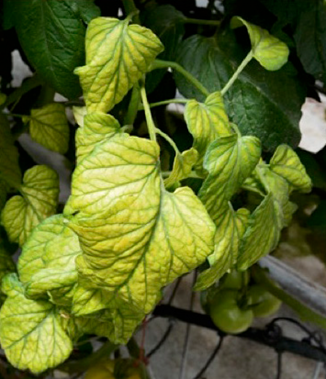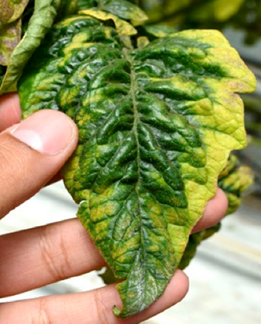Tomato chlorotic dwarf viroid
Tomato chlorotic dwarf viroid (TCDVd) is a viroid plant pathogen which infects a range of Solanaceous vegetables and ornamentals. It is a Pospiviroid that is closely related to potato tuber spindle viroid (PSTVd), and it can cause significant damage and yield loss in tomatoes. TCDVd prefers warmer climates. It multiplies rapidly at temperatures between 25-35˚C and more slowly at temperatures lower than this.
TCDVd is a quarantine pest in Australia due to its severe impacts on tomato plants. If TCDVd is detected on your property, extra precautions should be taken to minimise spread of the viroid.
Symptoms of TCDVd
TCDVd can cause severe disease and economic loss in tomato, its preferred host. Infected tomato plants often have severely stunted growth, as well as chlorotic (yellow) and distorted leaves (Figures 1 and 2). The tomato fruit can also become split or cracked and be reduced in size.
Alt text: The image shows a cluster of yellowed tomato leaves which have curled in edges.

Alt text: The image shows a close-up of a single tomato leave that has yellowed on the edges but is still green in the middle. The overall leaf is lumpy and distorted.

Ornamental plants infected with TCDVd usually do not have symptoms, and as such, the viroid can be difficult to detect in ornamental nurseries. If there is a chance that TCDVd is present on your property, it is important to practice good hygiene when handling different TCDVd host plants. Asymptomatic plants often act as a reservoir for infectious material and can increase the chance of spread. This poses significant risk to the tomato industry.
Hosts of TCDVd
- Known hosts include Solanaceous species and some ornamental flowers (Olmedo-Velarde et al. 2017; CABI 2022), including:
- - Petunia
- - Petunia hybrida
- - Tomato (Solanum lycopersicum)
- - Eggplant (Solanum melongena)
- - Trailing verbena (Verbena x hybrida)
- - Dwarf periwinkle (Vinca minor)
- - Scarlet angel’s trumpet (Brugmansia sanguinea)
- Suspected hosts (Olmedo-Velarde et al. 2017) include:
- - Lobelia (Lobelia erinus)
- - Marigolds (Calendula officinalis, Tagetes spp.)
- - Dahlia (Dahlia spp.)
- - Capsicum (Capsicum annum)
- - Jimsonweed (Datura spp.)
- - Nicotiana spp.
Spread of TCDVd
TCDVd spreads extremely easily via contact. It transmits via:
- contact between infected and uninfected plants by touching
- people handling infected plants first, and then uninfected plants without applying hygiene measures in between. Even contaminated clothing can transfer the viroid
- tools (e.g., secateurs) and equipment being used on infected and uninfected plants without being sanitised in between
- sowing infected seeds
- The viroid can be very persistent on surfaces, so it is important to implement hygiene measures and protocols to minimise the chance of spread and contamination. Insect vectors for TCDVd are not yet known to occur in Australia.
Preventing the spread of TCDVd
The only available measure to eradicate the viroid if it is on your property is to destroy all infected plant material. Infected plant material should be disposed of by deep burial or burning. Alternatively, a biosecurity waste disposal service can be used. Do not re-use or compost suspect or confirmed infected material on-site.
To limit the spread of TCDVd on your property:
- immediately isolate any suspect plants and limit access by personnel
- always work in “clean” areas before moving into “infected” areas
- sanitise all surfaces, tools, equipment, clothing, and other materials that may have come into contact with infected plants, with 2% Virkon S or 10% bleach (sodium hypochlorite, e.g., White King)
- use disposable gloves when handling suspect plants and change them frequently, particularly when handling different host plants
- change clothes and shoes when leaving “infected” areas. Alternatively, sterilise shoes using foot baths
To prevent new or re-infection, only use tested and healthy planting or propagation material.
Some additional hygiene measures that may be used include:
- make equipment and tools room/shed/area specific and do not move them out of the designated spaces
- cover infected plant material and waste with a tarp when transporting them. Sterilise the transport container and tarp with bleach or Virkon S after each trip.
- Ensure that all areas are regularly cleared of plant waste and sterilised.
Distribution of TCDVd
TCDVd is currently known to be present in parts of Europe, India, Japan, and the United States.
Reporting an unusual pest or disease of plants or honey bees
Report any unusual plant pest or disease immediately using our online reporting system or by calling the Exotic Plant Pest Hotline on 1 800 084 881. Early reporting increases the chance of effective control and eradication.
Please take good quality photos of the pests or damage to include in your report where possible, as this is essential for rapid pest and disease diagnosis and response. For tips on how to take a good photo, visit the Cesar Australia photo for identification guide.
Your report will be responded to by an experienced staff member who will seek information about the detection and explain next steps, which may include a site visit and sampling to confirm the pest or disease.
Report onlineReferences
CABI (2022) Tomato chlorotic dwarf viroid. CAB International. www.cabi.org/isc. Accessed 5 July 2022
Matsushita Y, Usugi T, Tsuda S (2009) Host range and properties of Tomato chlorotic dwarf viroid. European Journal of Plant Pathology 124 (2):349-352. doi:10.1007/s10658-008-9416-9
Matsuura S, Matsushita Y, Kozuka R, Shimizu S, Tsuda S (2009) Transmission of Tomato chlorotic dwarf viroid by bumblebees (Bombus ignitus) in tomato plants. European Journal of Plant Pathology 126 (1):111. doi:10.1007/s10658-009-9515-2
Olmedo-Velarde A, Hamasaki R, Bushe B, Melzer M (2017) Tomato chlorotic dwarf viroid. University of Hawaii at Manoa. Accessed 5 July 2022
Shiraishi T, Maejima K, Komatsu K, Hashimoto M, Okano Y, Kitazawa Y, Yamaji Y, Namba S (2013) First report of tomato chlorotic dwarf viroid isolated from symptomless petunia plants (Petunia spp.) in Japan. Journal of General Plant Pathology : JGPP 79 (3):214-216. doi:https://doi.org/10.1007/s10327-013-0444-8
Singh, RP & Dilworth, AD 2009, ‘Tomato chlorotic dwarf viroid in the ornamental plant Vinca minor and its transmission through tomato seed’, European Journal of Plant Pathology, vol. 123, pp. 111-6.
Verhoeven JTJ, Hammond RW, Stancanelli G (2017) Chapter 3 - Economic Significance of Viroids in Ornamental Crops. In: Hadidi A, Flores R, Randles JW, Palukaitis P (eds) Viroids and Satellites. Academic Press, Boston, pp 27-38. doi:https://doi.org/10.1016/B978-0-12-801498-1.00003-6